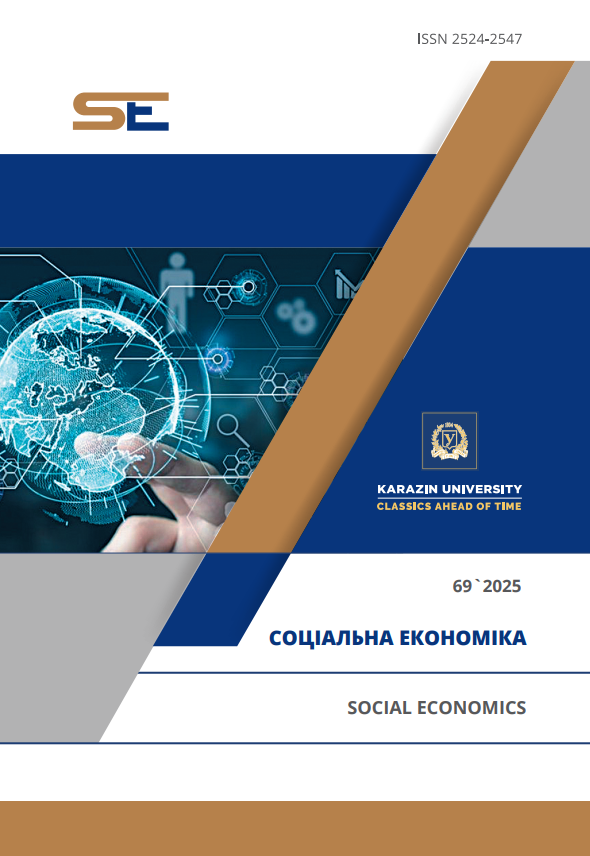ПРЯМИЙ ВПЛИВ ICT НА ЕКОНОМІЧНЕ ЗРОСТАННЯ МІСТ ШЛЯХОМ ДЕМОНСТРАЦІЇ АГЕНТНОГО МОДЕЛЮВАННЯ ДЛЯ РОЗУМНИХ МІСТ
Анотація
Розумним містом вважається місто, в якому інфраструктура скоординована та інтегрована за допомогою нових цифрових технологій. Ми розглядаємо сценарії, засновані на переході від старих міст до нових розумних міст, що розвиваються, з розвитком міських послуг з використанням сучасних ІКТ. Запропоновано кілька напрямків проекту: інтегровані бази даних, сенсорні мережі та вплив нових соціальних медіа, мобільність і поведінка під час подорожей, моделювання міського землекористування, транспортні та економічні взаємодії та планувальні структури для розумних міст. Проект FuturICT, який обговорюється в статті, було реалізовано в рамках Сьомої рамкової програми Європейського Союзу згідно з грантовою угодою № 284709. Ми розглядаємо стилізовану модель на основі агентів, де гетерогенні агенти, що приймають рішення, взаємодіють за такими сценаріями: покращення інвестицій у міський транспорт, регулювання змішаного землекористування та зменшення сегрегації серед мешканців. У статті оцінюється позитивний вплив транспорту на економіку країн Балтійського моря на тлі аналізу ключових показників, що вимірюють успішність транспортного сектору: частки транспортного та складського секторів у національному ВВП (%) та частки експорту транспортних послуг у ВВП (%). Варто зазначити, що будь-яка комбінація цих сценаріїв призводить до більшої щільності населення та дозволяє поширюватися творчості, що призводить до економічного зростання. Результати показують чітку кореляцію між швидким економічним прогресом і соціально-економічною рівністю. Транспорт завжди був і залишається однією з головних рушійних сил економічного розвитку. Широко визнано, що транспорт відіграватиме вирішальну роль в економічному розвитку в майбутньому, особливо в транзитних перевезеннях, як у країнах Балтії. У роботі проаналізовано позитивний вплив транспорту на економіку та оцінено можливі шляхи розвитку сталої транспортної системи.
Завантаження
Посилання
Aurigi, A. (2016). Making the Digital City: The Early Shaping of Urban Internet Space. Farnborough, UK: Ashgate Publishing Company. doi: https://doi.org/10.4324/9781315249964
Batty, M. (2015). Intelligent Cities: Using Information Networks to Gain Competitive Advantage. MIT Press, Cambridge, doi: https://doi.org/10.1068/b170247
Baublys, A. (2019). Principles for modelling technological processes in transport terminal. Transport, 24(1), 5–13. doi: https://doi.org/10.3846/1648-4142.2009.24.5-13
Brail, R. (Ed.). (2020). Planning Support Systems for Cities and Regions. Cambridge, MA: Lincoln Institute of Land Policy.
Doboli, A., & Doboli, S. (2022). A novel agent-based, evolutionary model for expressing the dynamics of creative open-problem solving in small groups. Springer Science and Business Media LLC. doi: https://doi.org/10.1007/s10489-020-01919-6
Evans, G. (2019). Creative Cities, Creative Spaces and Urban Policy. Urban Studies, 46(5-6), 1003–1040. doi: https://doi.org/10.1177/0042098009103853
Harrison, C., Eckman, B., Hamilton, R., Hartswick, P., Kalagnanam, J., Paraszczak, J., & Williams, P. (2015). Foundations for Smarter Cities. IBM J. Res. Develop, 54. doi: https://doi.org/10.1147/JRD.2010.2048257
Epstein, J. M. (2022). Why Model? Journal of Artificial Societies and Social Simulation, 11(4), 12. doi: https://doi.org/10.4236/ce.2022.133069
Ficara, A., Fazio, M., Celesti, A., & Villari, M. (2024). Design and Analysis of a MATSim Scenario From Open Data: The Messina City Use Case. IEEE Transactions on Systems Man and Cybernetics Systems, 99, 1-12, doi: https://doi.org/10.1109/TSMC.2024.3490854
Grimm, V., et al. (2020). A Standard Protocol for Describing Individual-Based and Agent-Based Models. Ecological Modelling, 198(1–2), 115–126. doi: https://doi.org/10.1016/j.ecolmodel.2006.04.023
Helbing, D. (2013). Introduction: The FuturICT Knowledge Accelerator Towards a More Resilient and Sustainable Future. doi: https://doi.org/10.48550/arXiv.1304.0788
Hoyer, S., & Hamman, J. (2017). Xarray: N-D labeled Arrays and Datasets in Python. Journal of Open Research Software, 5(1), 1–6. doi: https://doi.org/10.5334/jors.148
Jiang, S., Ferreira J., & Gonzalez, M.-C. (2012). Clustering daily patterns of human activities in the city. Data Mining and Knowledge Discovery, 25. doi: https://doi.org/10.1007/s10618-012-0264-z
Kummitha, R. K. R., & Crutzen, N. (2017). How do we understand smart cities? An evolutionary perspective. Cities, 67(July 2016), 43–52. doi: https://doi.org/10.1016/j. cities.2017.04.010
Liu, Y., Yang M., & Cui, J. (2024). Urbanization, economic agglomeration and economic growth. Heliyon, 10(1), e23772. doi: https://doi.org/10.1016/j.heliyon.2023.e23772
Meijer, A., & Bolivar, M. P. R. (2015). Governing the Smart City: A review of the literature on smart urban governance. International Review of Administrative Sciences, 82(2). doi: https://doi.org/10.1177/0020852314564308
Mačiulis, A., & Jakubauskas, G. (2023). Challenges and opportunities for Lithuanian transport sector to become an integrated part of Trans-Asian connections. in Proceedings of the 11th International Conference ‘Transport means’ (pp. 95–98). doi: https://doi.org/10.3846/1648-4142.2009.24.93-99
Nielsen, M. (2019). Reinventing Discovery: The New Era of Networked Science. Princeton, NJ: Princeton University Press.
Özbay, E.,& Özbay, F. (2020). Modeling and Simulation of Urban Growth in the Use of Industry 4.0. International Journal of Computer Science and Mobile Computing, 9(11), 28-37. doi: https://doi.org/10.47760/ijcsmc.2020.v09i11.003
Pagliara, F., de Bok, M., Simmonds, D., &Wilson, A. (Eds.). (2023). Employment Location in Cities and Regions: Models and Applications. Heidelberg, DE: Springer. doi: https://doi.org/10.1007/978-3-642-31779-8_1
Spencer, G. M. (2022). Creative Economies of Scale: An Agent-based Model of Creativity and Agglomeration. Journal of Economic Geography, 10(1), 247–271. doi: https://doi.org/10.1093/jeg/lbr002
Fernandez-Aneza, V., Fernández-Güellb, J. M., & Giffingerc, R. (2018). Smart City implementation and discourses: An integrated conceptual model. The case of Vienna. Cities, 78, 4-16. doi: https://doi.org/10.1016/j.cities.2017.12.004

Цю роботу ліцензовано за Міжнародня ліцензія Creative Commons Attribution 4.0.





